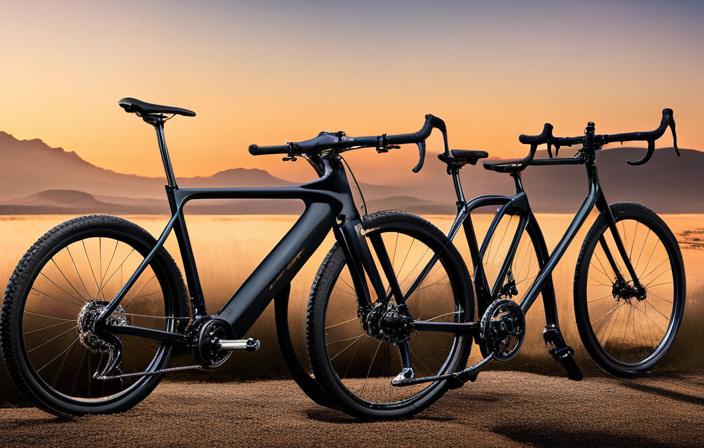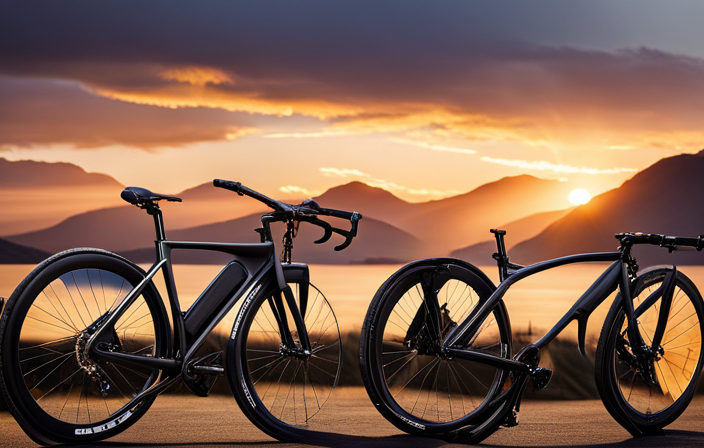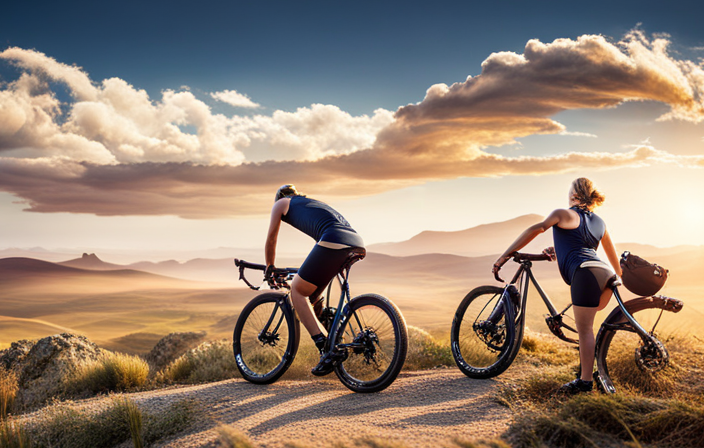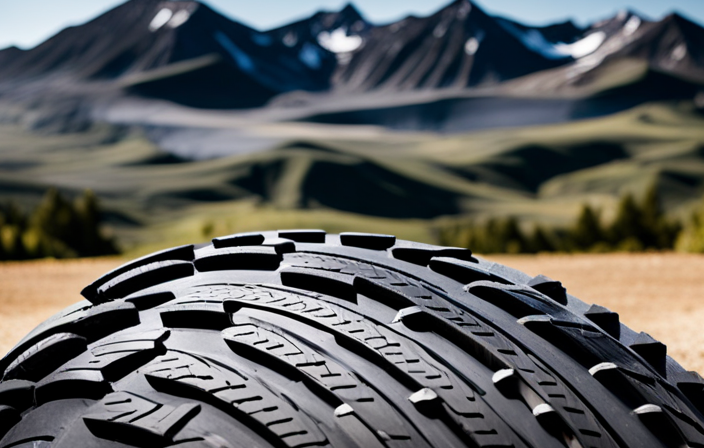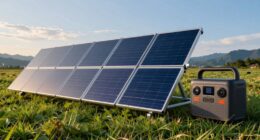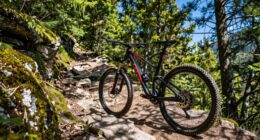Can my gravel bike handle the terrain I want to ride on? This is a common question many gravel cyclists ponder when encountering tough routes. In this article, we will delve into the important factors to think about in determining if your bike is appropriate for various types of terrain.
From frame and tire clearance to suspension options and gear ratios, we will delve into the technical details that can make or break your off-road adventures.
So let’s dive in and find out if your gravel bike is up for the challenge!
Key Takeaways
- Check the frame and tire clearance to ensure there is enough space for wider tires and to prevent rubbing or interference.
- Consider suspension options such as a suspension fork or seatpost suspension to improve comfort and reduce fatigue on different terrains.
- Select appropriate gear ratios and brake type for optimal pedaling efficiency and stopping power.
- Choose tires with suitable tread patterns and wider widths for improved stability, traction, and control on rough terrains.
Frame and Tire Clearance
You’ll need to check if your gravel bike has enough frame and tire clearance. This is crucial for ensuring that your bike can handle various types of terrain without compromising its performance or safety.
When it comes to frame clearance, you should consider the space between the tires and the frame. Ideally, there should be enough room to accommodate wider tires, which provide better stability on rough surfaces. Additionally, you’ll want to ensure that the saddle height allows for comfortable pedaling and proper leg extension. The handlebar position is another important factor to consider. It should be adjusted in a way that promotes good posture and control while riding on different terrains.
To determine if your gravel bike can go on various terrains, start by measuring the clearance between your tires and frame using a tape measure or ruler. Compare this measurement with the maximum tire width recommended by the manufacturer. Similarly, evaluate your saddle height and handlebar position relative to your body proportions for optimal comfort and control.
Now let’s move on to discussing suspension options…
Suspension Options
Consider different suspension options to determine the suitability of your gravel bike for various types of terrain. Suspension can greatly impact the comfort and performance of your ride, especially when facing rough or uneven surfaces.
One option to enhance your bike’s suspension is a suspension fork. This component attaches to the front wheel and absorbs shocks from bumps and obstacles, providing a smoother ride. It helps maintain control and stability on challenging terrains such as rocky trails or gravel roads with deep potholes.
Another option to consider is a seatpost suspension. This type of suspension is installed on the seatpost, allowing it to absorb vibrations and impacts from rough surfaces. It helps reduce fatigue and improves overall comfort during long rides on bumpy terrain.
When evaluating whether these suspension options are suitable for your gravel bike, consider factors such as the type of terrain you plan to ride on regularly, your riding style, and personal preferences. Keep in mind that adding suspension components may increase weight and affect the bike’s handling characteristics.
With proper suspension choices, you’ll be well-equipped to tackle different terrains with confidence.
Now let’s explore another important aspect of gravel biking: gear ratios…
Gear Ratios
To optimize your gravel biking experience, it’s important to understand how different gear ratios can impact your performance. Gear ratios refer to the relationship between the number of teeth on the front chainring and the number of teeth on the rear cassette. This determines how easy or difficult it is to pedal in certain conditions.
When it comes to gear ratios, gear maintenance plays a crucial role. Keeping your gears clean and properly lubricated will ensure smooth shifting and prevent wear and tear. Regularly inspecting your gears for any signs of damage or excessive wear is also important for optimal performance.
Gear selection is another key aspect to consider. Gravel biking often involves varying terrain, from flat roads to steep climbs and rough trails. Choosing the right gear ratio for each situation can make a significant difference in your ability to tackle different terrains efficiently.
Transitioning into the subsequent section about brake type, understanding gear ratios goes hand in hand with selecting appropriate brakes for gravel biking. Brake type is another essential factor that affects overall performance on different terrains.
Brake Type
Choosing the right brake type for your gravel biking adventures can greatly impact your overall performance on different terrains. When it comes to gravel biking, you need a brake system that offers precise brake modulation and sufficient braking power. Here are three key factors to consider:
-
Disc brakes: These are the most popular choice among gravel bikers due to their superior stopping power and consistent performance in all weather conditions. They come in two types – mechanical (cable-actuated) and hydraulic (fluid-actuated). Hydraulic disc brakes provide better modulation and require less effort at the lever.
-
Rim brakes: While not as common on gravel bikes, rim brakes are still an option for riders who prefer simplicity or have a bike without disc brake mounts. They offer good braking power but may be less effective in wet or muddy conditions.
-
Brake pad choice: Regardless of the brake type, choosing the right brake pads is crucial for optimal performance on different terrains. Sintered or metallic pads provide better stopping power and durability but can be noisier, while organic pads offer smoother modulation with less noise but wear out faster.
Transitioning into the subsequent section about tire tread and width, it’s important to note that the choice of brake type should complement your tire setup for maximum control and safety.
Tire Tread and Width
When considering tire tread and width for my gravel bike, it is crucial to choose tires with suitable tread patterns for different terrains. This will ensure optimal performance and grip on various surfaces such as loose gravel, mud, or pavement.
Additionally, opting for wider tires will provide improved stability and traction, especially when riding over rough or uneven terrain.
By selecting the right combination of tread pattern and tire width, I can enhance my overall riding experience and confidently conquer any type of terrain.
Choose tires with suitable tread patterns for different terrains
One way to determine if your gravel bike can handle different terrains is by selecting tires with suitable tread patterns. The tire tread plays a crucial role in providing grip and traction on various surfaces, such as loose gravel, mud, or pavement. Additionally, the width of the tires also affects their performance on different terrains.
To make an informed decision about tire selection, consider factors like tire pressure and tubeless setup for optimal performance. Adjusting the tire pressure based on the terrain can greatly enhance control and comfort while riding. Tubeless setups provide better puncture protection and allow for lower pressures without risking pinch flats.
When choosing tires with suitable tread patterns, it’s essential to understand which patterns work best for specific terrains. Here is a table summarizing common tread patterns and their suitability:
| Tread Pattern | Terrain Suitability |
|---|---|
| Knobby | Loose gravel, mud |
| Slick | Pavement |
| Mixed | All-around |
Opt for wider tires for improved stability and traction on rougher terrains. This will ensure a smoother ride experience with enhanced control over varying surfaces.
Opt for wider tires for improved stability and traction
Opting for wider tires on your gravel bike will provide improved stability and traction on various terrains. When considering the fit of these tires, it is important to ensure that they have enough clearance within the frame and fork of your bike. This prevents any rubbing or interference that could hinder your riding experience.
Additionally, wider tires allow for lower tire pressure, which enhances grip and comfort on rough surfaces. However, it is crucial to strike a balance between width and clearance to avoid compromising the handling of your bike. Finding the optimal tire pressure is also essential as it affects both traction and rolling resistance. Experimenting with different pressures can help you determine the sweet spot for your specific terrain preferences.
Now let’s transition into discussing handlebar type without further delay.
Handlebar Type
The type of handlebar on your gravel bike will determine its suitability for different terrains. Two key factors to consider when evaluating handlebars are handlebar height and handlebar width. The height of the handlebar affects your riding position and comfort, while the width impacts stability and control.
Handlebar height refers to the distance between the ground and the top of the handlebars. A higher handlebar provides a more upright riding position, which is advantageous for long rides or rough terrains as it reduces strain on your back and neck. On the other hand, a lower handlebar offers a more aerodynamic position that enhances speed but may be less comfortable over extended periods.
Handlebar width influences your ability to maneuver through narrow trails or obstacles. A wider handlebar provides better stability by increasing leverage and control, especially when navigating technical sections or descending at high speeds. Conversely, a narrower bar enables easier maneuverability in tight spaces.
Consider these factors when choosing a suitable handlebar for your gravel bike based on your preferred terrain and riding style. Now let’s transition into discussing frame materials without missing a beat.
Frame Material
When it comes to off-road riding, it’s crucial to determine if your bike’s frame is sturdy enough for the terrain. Assessing the durability of the frame material is key in ensuring a safe and enjoyable ride.
If necessary, consider upgrading to a more robust frame material that can withstand the demands of off-road trails.
Determine if your bike’s frame is sturdy enough for off-road riding
To determine if your gravel bike can handle off-road riding, you’ll need to check if the frame is sturdy enough. The frame material plays a crucial role in determining the bike’s durability and ability to withstand rough terrains. When assessing your bike’s frame, consider the following factors: gear selection and bike maintenance. These aspects directly impact the stress placed on the frame during off-road riding.
To help you evaluate your gravel bike’s frame, take a look at the table below:
| Frame Material | Durability Rating |
|---|---|
| Aluminum | Moderate |
| Steel | High |
| Carbon Fiber | Low |
Based on this information, if you find that your current frame material has a low durability rating for off-road riding, it might be worth considering upgrading to a more durable frame material. This will ensure that your gravel bike can withstand even the toughest terrains without compromising its performance or safety.
Consider upgrading to a more durable frame material if necessary
Consider upgrading to a more durable frame material in order to ensure your gravel bike can withstand rough terrains without compromising its performance or safety. Upgrading the frame can provide added strength and stability, allowing you to tackle challenging off-road trails with confidence.
When upgrading your frame, there are several factors to consider. First, check the tire clearance of your new frame to ensure it can accommodate wider tires for improved traction on uneven surfaces. Additionally, explore suspension options that suit your riding style and terrain preferences.
Next, evaluate gear ratios that will allow you to efficiently pedal through varying terrains. Consider the brake type that best suits your needs, as well as tire tread and width for optimal grip.
Lastly, think about handlebar type for enhanced control and comfort, while also considering weight distribution for better handling. Transitioning into the subsequent section about ‘weight distribution,’ it is crucial to test and evaluate these upgrades thoroughly before hitting the trail.
Weight Distribution
You should check if your gravel bike has proper weight distribution for different terrains. Weight distribution plays a crucial role in determining the performance and stability of your bike on various surfaces. A well-balanced weight distribution ensures that the bike handles predictably and maintains traction, especially when encountering rough or uneven terrain.
To assess weight distribution, start by considering the bike fit. Ensure that your body is properly positioned on the bike, with adequate weight over both wheels. This can be achieved through adjusting saddle position, handlebar height, and stem length to match your body proportions.
Additionally, pay attention to how much weight is distributed between the front and rear wheels. Ideally, there should be a balance between the two to optimize control and maneuverability. Too much weight on either wheel can lead to instability or difficulty in steering.
Proper weight distribution will enhance your gravel biking experience by providing better control and minimizing fatigue during rides across different terrains.
Transitioning into the next section about ‘suspension lockout,’ it is essential to consider this feature as it further enhances control by allowing you to adjust suspension settings depending on the terrain conditions encountered throughout your ride.
Suspension Lockout
I always make sure to check if my gravel bike has a suspension lockout feature before heading out on different terrains. This feature allows me to engage the lockout and enjoy more efficient pedaling on smoother surfaces, as it minimizes unnecessary suspension movement.
By utilizing the lockout, I can optimize my energy transfer and ensure a smoother ride while maintaining control over my bike’s performance.
Check if your bike has a suspension lockout feature
To determine if your gravel bike can handle rough terrain, check if it has a suspension lockout feature. This is an important aspect of bike maintenance as it allows you to optimize performance and comfort in different terrains.
Here are three key benefits of having a suspension lockout on your bike:
-
Improved climbing: Engaging the suspension lockout while climbing helps transfer power more efficiently to the wheels, reducing energy loss through suspension movement.
-
Better handling on smooth surfaces: When cycling on smooth or paved roads, locking out the suspension prevents unnecessary bouncing and bobbing, providing a more stable ride.
-
Longer endurance rides: By using the lockout feature during long rides on flatter terrain, you can conserve energy and maintain a faster pace.
Using the suspension lockout for more efficient pedaling on smoother surfaces enhances overall riding experience.
Now let’s explore how to use this feature effectively.
Use the lockout for more efficient pedaling on smoother surfaces
When riding on smoother surfaces, I always make sure to use the lockout feature on my gravel bike. This feature allows me to have a more efficient pedaling experience by minimizing energy loss from suspension movement. By engaging the lockout, I can prevent unnecessary bobbing and bouncing of the bike, which can slow me down. This is especially important when riding on flatter terrains or paved roads where suspension movement is not necessary.
In addition to using the lockout feature, tire selection also plays a crucial role in maximizing efficiency. Opting for tires with lower rolling resistance will further enhance your pedaling efficiency on smoother surfaces. These tires have a smoother tread pattern and are designed to reduce friction with the road, allowing you to glide effortlessly.
Now let’s move onto another important aspect of optimizing your gravel bike’s performance: pedal type.
Pedal Type
Determining the pedal type on your gravel bike can help determine its suitability for different terrains. When it comes to pedal efficiency and foot retention, choosing the right pedals is crucial. There are various types of pedals available, each with its own advantages and disadvantages. To help you make an informed decision, here is a table comparing three common pedal types:
| Pedal Type | Description | Pros | Cons |
|---|---|---|---|
| Flat Pedals | Simple platform pedals without any clips | Easy to get on and off | Less efficient pedaling |
| Toe Clip | Straps that secure the foot to the pedal | Better power transfer | Difficult to get in and out |
| Clipless | Shoes with cleats that attach to the pedal | Excellent power transfer | Requires special cycling shoes |
By considering factors such as pedal efficiency and foot retention, you can choose the most suitable option for your riding style and terrain preferences. Now let’s transition into discussing another important aspect of determining if your gravel bike can handle different terrains: wheel size.
Wheel Size
When it comes to determining if my gravel bike’s wheel size is suitable for different terrains, I need to consider the rollover capabilities.
Switching to larger wheels can provide better rollover capabilities, allowing me to tackle rougher terrains with ease.
By opting for larger wheels, I can ensure a smoother and more stable ride on various surfaces, enhancing my overall biking experience.
Determine if your bike’s wheel size is suitable for different terrains
To determine if your bike’s wheel size is suitable for different terrains, you should consider the type of terrain you plan on riding. For rougher terrains such as gravel or off-road trails, a larger wheel size may be more appropriate.
Larger wheels offer better rollover capabilities, allowing you to navigate obstacles with greater ease and stability. Additionally, a suspension fork can also enhance your bike’s ability to handle uneven surfaces by absorbing impacts and providing a smoother ride.
Another factor to consider is tire pressure. Adjusting the tire pressure can significantly impact your bike’s performance on various terrains. Lower tire pressure provides better traction and control on loose surfaces like gravel or dirt roads. Conversely, higher tire pressure is ideal for smoother surfaces like pavement or concrete paths.
So, when considering different terrains, it may be beneficial to switch to larger wheels for better rollover capabilities and adjust your tire pressure accordingly.
Consider switching to larger wheels for better rollover capabilities
Consider switching to larger wheels for better rollover capabilities, as they offer improved navigation over obstacles and a more stable ride. Larger wheels have a larger contact patch with the ground, allowing them to roll over rocks, roots, and other rough terrain more easily. This can make a significant difference in your ability to maintain control and momentum on challenging surfaces.
Additionally, larger wheels provide a smoother ride by absorbing bumps and vibrations more effectively. To further enhance your gravel bike’s performance, consider switching to tubeless tires. Tubeless tires eliminate the risk of pinch flats and allow you to run lower tire pressures for increased traction and comfort.
Another accessory worth considering is a dropper post, which can help you navigate steep descents by lowering your center of gravity and improving bike handling. With these upgrades in place, you’ll be ready to tackle any terrain with confidence.
Moving on to bike accessories…
Bike Accessories
You can enhance your gravel bike with accessories like a handlebar bag or frame bags. These accessories are great for carrying extra gear and supplies on long rides or bikepacking trips.
A handlebar bag attaches to the front of your bike’s handlebars and provides convenient storage for items you need quick access to, such as snacks, a small camera, or bike lights.
Frame bags, on the other hand, attach to the frame of your bike and offer larger storage capacity for things like spare tubes, tools, or even a change of clothes.
Bike lights are an essential accessory for riding in low light conditions or at night. They help increase your visibility to other road users and ensure that you can see where you’re going. There are many different types of bike lights available, ranging from small LED lights that clip onto your handlebars or helmet to larger rechargeable lights that provide brighter illumination.
Saddle bags are another useful accessory for gravel biking. These bags attach underneath your saddle and provide additional storage space without adding too much weight to your bike. They’re perfect for carrying essentials like a tire repair kit, CO2 cartridges, or snacks.
Incorporating these accessories into your gravel bike setup will make it more versatile and suitable for various terrains and riding conditions. The next section will cover suspension setup in order to further optimize your gravel biking experience.
Suspension Setup
When it comes to suspension setup, it’s crucial to adjust the settings according to the terrain I’ll be riding on. By doing so, I can ensure optimal performance and control over my gravel bike.
Experimenting with different settings will allow me to find the perfect balance between comfort and responsiveness, enhancing my overall riding experience.
Adjust the suspension settings to match the terrain you’ll be riding on
To properly match the terrain you’ll be riding on, adjust the suspension settings of your gravel bike.
Properly adjusting the suspension is crucial for achieving optimal performance and comfort while riding.
The first step in adjusting the suspension is to consider the compatibility of your bike’s current setup with the terrain you’ll be encountering.
Different terrains require different suspension characteristics, such as more travel for rough off-road trails or less travel for smoother surfaces.
By adjusting factors such as sag, rebound, and compression damping, you can fine-tune your bike’s suspension to suit specific terrains.
Experimenting with different settings will help you find the optimal balance between comfort and control, ensuring a smooth and enjoyable ride across various types of terrain.
Experiment with different settings to find the optimal balance
Try experimenting with different suspension settings to find the optimal balance for your ride. This is crucial because it allows you to fine-tune your gravel bike’s performance and adapt it to various terrains. Here are three key areas to focus on:
-
Experiment with tire pressure: Adjusting tire pressure can greatly impact your bike’s handling and comfort on different surfaces. Lower tire pressure provides better traction and absorbs shocks, making it ideal for rough terrains like gravel or dirt roads. Higher pressure, on the other hand, reduces rolling resistance and improves efficiency on smoother surfaces.
-
Test different handlebar positions: The position of your handlebars affects your body posture, which in turn impacts control and stability. For off-road riding, a wider handlebar can enhance maneuverability and give you more control over rough terrain.
-
Fine-tune suspension dampening: Suspension dampening determines how much shock absorption occurs when riding over bumps or uneven surfaces. Experimenting with the compression and rebound settings can help you find the right balance between comfort and responsiveness.
By exploring these adjustments, you’ll be able to optimize your gravel bike’s performance for any type of terrain while enhancing your overall biking experience.
Transition sentence: Developing strong bike handling skills is also essential for tackling challenging terrains effectively without compromising safety or control.
Bike Handling Skills
Bike handling skills are crucial when determining if your gravel bike can handle certain terrains. These skills include the ability to maintain balance, control the bike at high speeds, and navigate through obstacles safely. Additionally, having a proper bike fit is essential for optimal handling. The position of the saddle, handlebars, and pedals must be adjusted correctly to ensure comfort and stability while riding.
To improve your bike handling skills, practice maneuvers such as cornering, braking, and descending on various surfaces. Cornering requires leaning into turns while maintaining control of the bike’s trajectory. Braking techniques involve modulating brake pressure to avoid skidding or losing control. When descending on rough terrain, it’s important to distribute your weight properly between the front and rear wheels for maximum traction.
Incorporating these techniques will enhance your confidence and control over your gravel bike when encountering different terrains. It is important to test and evaluate how well you can handle your gravel bike in real-world scenarios before venturing onto more challenging terrain. By doing so, you can determine if adjustments need to be made to optimize performance for specific conditions without compromising safety or comfort.
Test and Evaluate
Before venturing onto more challenging terrain, I always make sure to thoroughly test and evaluate my gravel bike to ensure it meets my needs and expectations. Testing and evaluating a gravel bike can be done using various methods and criteria.
One important aspect to consider is the bike’s stability on different terrains. To assess this, I take my bike on a variety of surfaces such as loose gravel, dirt trails, and rough roads. This allows me to gauge how well the bike handles in different conditions. Additionally, I pay attention to its responsiveness when navigating through obstacles like rocks or tree roots.
Another important factor is the bike’s durability. I test its ability to withstand vibrations by riding over bumpy sections at varying speeds. I also check for any signs of wear or damage after each ride.
Comfort is another crucial aspect that needs careful evaluation. To determine this, I take the bike on longer rides over different types of terrain, paying attention to how it absorbs shocks and impacts.
Lastly, I consider the overall performance of the bike in terms of speed and efficiency. Test rides on both flat roads and hilly terrain help me assess its capabilities in different scenarios.
By following these testing methods and evaluating criteria, I can confidently determine if my gravel bike is suitable for various terrains before embarking on any adventure.
Frequently Asked Questions
How do I choose the right gear ratios for my gravel bike?
When choosing gear ratios for gravel biking, it’s crucial to consider the terrain you’ll be riding on and your personal preferences. Optimal gear ratios can enhance your performance and efficiency.
Additionally, suspension plays a vital role in gravel bikes as it helps absorb the impact of uneven surfaces, providing a smoother ride. It’s essential to select gear ratios that allow you to tackle different gradients and maintain a comfortable cadence while taking advantage of the suspension’s capabilities.
What type of brake should I use for off-road terrain?
When it comes to off-road terrain, choosing the right brake is crucial. Brake modulation is key in navigating treacherous paths with control and precision.
Hydraulic brakes offer unparalleled modulation by using fluid pressure to provide consistent stopping power. On the other hand, mechanical brakes rely on cables and springs, offering a more straightforward setup but potentially sacrificing modulation.
Consider your skill level and the intensity of your off-road adventures when deciding which brake system is best for you.
What is the ideal tire tread and width for gravel riding?
The ideal tire tread and width for gravel riding depend on the specific terrain and riding conditions. For loose or muddy surfaces, a more aggressive tread pattern with larger knobs provides better traction.
A tire width between 35-45mm is commonly used for gravel riding as it offers a balance of comfort, stability, and grip. Additionally, running tubeless tires at an ideal pressure can further enhance performance by reducing the risk of punctures and improving rolling resistance.
Can I use a different handlebar type on my gravel bike?
When considering different handlebar options for my gravel bike, it’s essential to weigh the advantages of drop bars versus flat bars.
Drop bars provide a more aerodynamic position, allowing for increased speed and efficiency on long rides. They also offer multiple hand positions, reducing fatigue and increasing comfort.
On the other hand, flat bars provide better control and stability on technical terrain, making them suitable for off-road adventures.
Ultimately, the choice depends on personal preference and the type of riding I plan to do.
What factors should I consider when selecting the pedal type for my gravel bike?
When selecting the pedal type for my gravel bike, I consider two important factors: pedal efficiency and shoe compatibility.
Pedal efficiency refers to how efficiently power is transferred from my legs to the bike. This can be influenced by various factors such as the design of the pedal system and the materials used.
Shoe compatibility is crucial as it determines whether my chosen pedals are compatible with my cycling shoes, ensuring a secure and comfortable fit while riding.
Conclusion
In conclusion, determining if your gravel bike is suitable for different terrains requires careful consideration of several factors. Just like a skilled sailor navigating through treacherous waters using a compass and chart, you must assess your bike’s frame clearance, tire tread and width, suspension options, gear ratios, brake type, and accessories to ensure a smooth ride.
Additionally, honing your bike handling skills is crucial in tackling challenging paths. Remember to test and evaluate your bike’s performance on various terrains before embarking on your next adventure.
Happy riding!
